This website illustrates fluorescent minerals, most were collected in southern California desert areas.
The top 9 images show minerals under white light (xenon flash), red light, and then under different bands of ultraviolet light (standard Bands A, B, C, 365 nM, and merged bands).
Click on images for a larger view. |
Click on the images to rotate through a series of photos to see how rocks and minerals appear under different wavelengths of visible and ultraviolet light. |
|
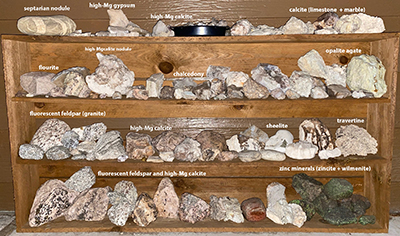
Minerals in white light (labeled). |
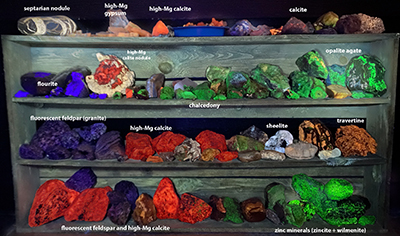
Minerals under all wavelengths of UV (labeled) |
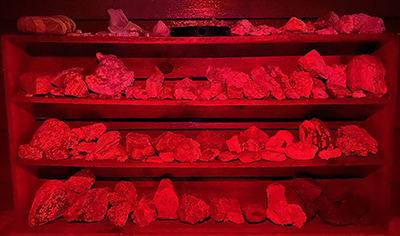 Minerals in red light. Minerals in red light. |

Minerals under long-wave ultraviolet light (Band A)
|

Minerals under mid-wave ultraviolet light (Band B) |
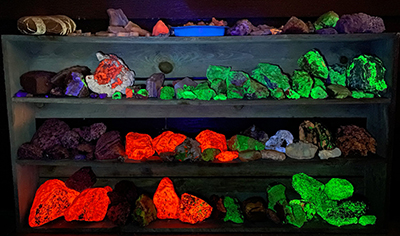
Minerals under short-wave ultraviolet light (Band C) |
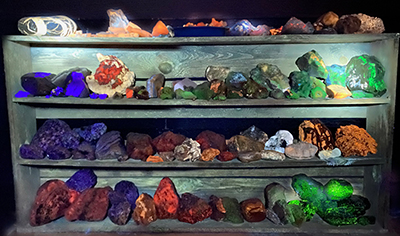
Minerals under 365nM (mid-range UV) torch lamp.
|
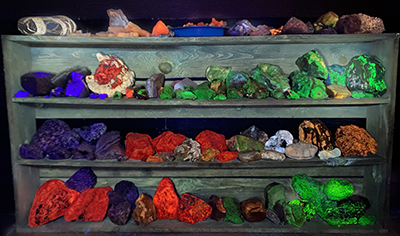
Minerals under all UV bands (mixed A+B+C + 365nM) |

Minerals under UV wavelengths A + B + C |
Note that improper exposure to ultraviolet light can be hazardous.
The UV region covers the wavelength range 100-400 nm (nannometers)
and is divided into three bands:
UVA (315-400 nm) - long-wave ultraviolet - generally non-hazardous under short-term exposure
UVB (280-315 nm) - midwave ultraviolet - mildly hazardous under short-term exposure (skin burn and eye damage).
UVC (100-280 nm) - short-wave ultraviolet - can cause skin burns and eye damage even with short-term exposure.
Eye and skin protection while using UV lamps is very important.
Mid-wave and short-wave ultraviolet light causes sunburn and UV lamps are more intense than sunlight.
Many different plants and animals also display fluorescence.
Examples include scorpions, moths, centipedes, millipedes, rattlesnakes, some plants, leaves, mushrooms, molds, and more.
Many man-made and natural organic compounds fluoresce. Clothing, trash materials, organic wastes, and urine are
often highly fluorescent.
The image below show examples of fluorescent mineral collecting equipment.
It is recommended to never go fluorescent mineral collecting alone! (Safety first!)
The last two images are displays of select classic fluorescent minerals. Many mineral museums and rock, gem & mineral clubs have fluorescent mineral displays and can provide guidance and information about fluorescent mineral collecting. Almost every area of the country has something that glows! |

A scorpion's chitonous shell glows under ultraviolet light. |
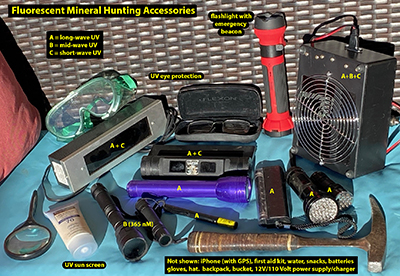
Equipment for collecting fluorescent minerals. |
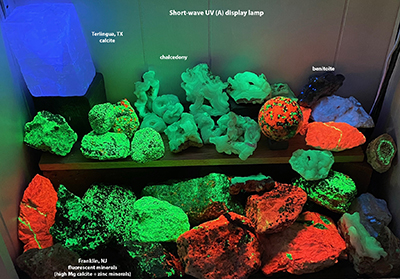
Mineral display case with 90 Watt shortwave lamp (Band C)
|

Mineral display case with standard blacklight bulb (Band A)
|
| https://gotbooks.miracosta.edu/fieldtrips/fluorescent_minerals/index.html |
2/2/2022 |
|


 Minerals in red light.
Minerals in red light.








